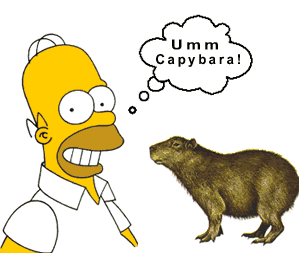This is my annual start of Lent post with Lenten trivia.
As I have said before I greatly admire those bloggers who give up blogging for Lent, but as for me I will continue blogging as a penance for others. I will try to provide you with plenty of punance during this punitential season.
This year I have decided that I will be giving up "giving up things" for Lent.
 |
The capybara kap-i-‘bar-uh, hydrochoerus hydrochaeris, is a semi-aquatic rodent of South and Central America. It is the only species in its genus, which belongs to the family Hydrochoeridae, order Rodentia.
When the Spanish missionaries found the capybara in Brazil during the 16th century, they wrote to the Pope to ask – there’s an animal here that’s scaly but also hairy, spends most of its time in the water but occasionally comes on land; can we classify it as a fish (and thus, the indigenous people could continue to eat it during Lent)?. Not having a clear description of the animal (and not wanting the petitioners to starve), the Pope agreed and declared it to be a fish.
The pretzel has a deep spiritual meaning for Lent. In fact, it was the ancient Christian Lenten bread as far back as the fourth century. In the old Roman Empire, the faithful kept a very strict fast all through Lent: no milk, no butter, no cheese, no eggs, no cream and no meat. They made small breads of water, flour and salt, to remind themselves that Lent was a time of prayer. They shaped these breads in the form of crossed arms for in those days they crossed their arms over the breast while praying. Therefore they called the breads “little arms” (bracellae). From this Latin word, the Germanic people later coined the term “pretzel.”
[Full Article]
The Teutonic word Lent, which we employ to denote the forty days’ fast preceding Easter, originally meant no more than the spring season. Still it has been used from the Anglo-Saxon period to translate the more significant Latin term quadragesima (Fr. car�me, It. quaresima, Span. cuaresma), meaning the “forty days”, or more literally the “fortieth day”. This in turn imitated the Greek name for Lent, tessarakoste (fortieth), a word formed on the analogy of Pentecost (pentekoste), which last was in use for the Jewish festival before New Testament times.
Carnival means "farewell to meat.”
It was thought that misfortune would come to those who married during lent – “Marry in Lent, live to repent” – because lent was a time for abstinence.
Jimmy Akin has a good roundup of Lenten information.
Jimmy also has the guidelines for fasting from the Code of Canon Law.
I have also changed one of my top graphics to this.

The Ox Files has a funny post on a new product for Ash Wednesday.
So I wish you all success in your Lenten cleaning and that this year you will grow closer to Christ.

7 comments
The 3rd Season of The Tick animated series has some great episodes featuring a pet Capybara lovingly called “Speak”. Funny stuff.
You say, “Not having a clear description of the animal (and not wanting the petitioners to starve), the Pope agreed and declared it to be a fish.” I think it would be better to say that the Pope said it could be considered equivalent to a fish for the purpose of applying the law of abstinence. Some non-Catholics claim that the Church taught that the capybara is a fish to try to discredit the Church by showing that it taught a doctrine which is demonstrably false. Here’s something I wrote several years ago when that claim came up elsewhere on the net:
The story that the Catholic Church said the capybara is a fish seems to be a misunderstanding. Unless someone can produce an official document saying that it is a fish, I will maintain that the Church said that the meat of the capybara could be eaten by Catholics when they were required to abstain from other flesh meat.
In other words the Church made an exception similar to the one in the famous, and maybe even authentic quotation:
“Any member introducing a dog into the Society’s premises shall be liable to a fine of one pound. Any animal leading a blind person shall be deemed to be a cat.”
— Rule 46, Oxford Union Society, London
I recall reading in a Catholic book years ago that a similar exception had been made involving whales, at least for Eskimos.
Any rulings on alligator?
I’ll see you later about that.
(It occurs to me that I might be the only one reading this who is old enough to catch the reference.)
Does Homer’s cappy have sprinkles?
Also, for some strange reason, as Hilaire Belloc reminds me, the government of England considers the Hippopotamus to be a BIRD.
Blogging as a penance for tohers! Brilliant!
(Did I mention I’m surrounded by folks who gave up buying their own smokes for Lent? Oh, I did? )
Comments are closed.